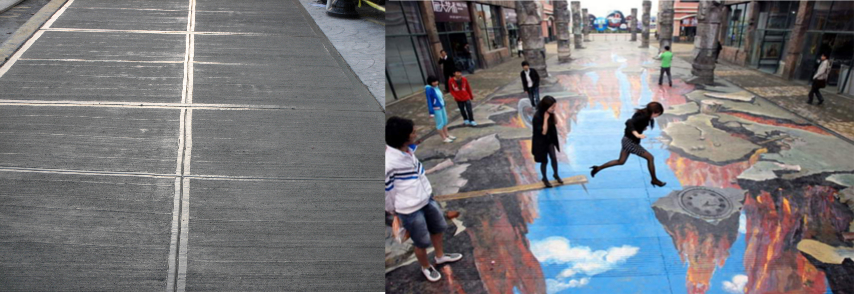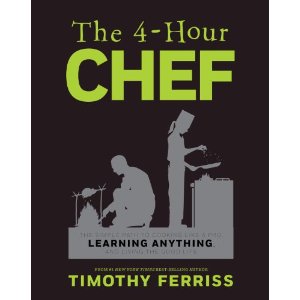Blog Entries
Colin put together another great video. This one does an even better job of showing actual training.
Voluntary limits are one of my favorite ways to keep training fresh and to come up with new ideas.
But why would you choose to limit your options in the first place? Everyone loves having choices. Having even more choices then could only be a good thing, right? Nope. When you have tons of options it can be difficult to choose what to do. Indecision is a great way to let that lazy part of your mind take over and think, "well, since you don't know what you want to do...why don't we just stay in this comfy seat right here instead?" Putting limits (rules if you prefer) in place narrows down your options and makes it easier to make a choice. In other words it removes the excuse of "but I don't know what to do!" You know what's really awesome about this entire concept? Limits can also be used to take a space devoid of compelling options, and turn it into a something better. Will it compare to the best training spaces? Nah, but it can still turn a bland space into a good one.

The easiest way to do this is to set rules for how you can navigate an area. The option I hope hope hope everyone is familiar with is the "floor is lava" game. One hell (hah?) of a way to inject some context and difficulty into any situation. In my last post I was using that during some parts of the video. What are some other simple limitations/rules to try?
- What can you do without one hand? One foot? How about no hands or no feet?
- What about using the same move twice? Or make it only usable a second time when linked to another.
- Stay on all fours the entire time. I love this one, but it can be super tiring. You've been warned. ;)
- Choose one route, but traverse it different ways each time.
- Pick a movement and play with different combinations. Make it more complicated by turning it into a sequence that you add onto gradually. Every place will have its own unique options you can try too, and that list is definitely not exhaustive either. I just find myself asking the question "what if I could only do this?" often when I'm training and that leads to all sorts of interesting situations. If you let yourself be creative and don't dismiss ideas because they seem silly, absurd, or even impossible then you will discover all sorts of things. It's all about having fun and enjoying the process, don't worry about trying to discover something amazing; if it happens it will; if not, then you still learned something.

Clearly I have been watching way too much Batman lately, but that's the first thing that comes to mind when the subject of mindfulness comes up. More to the point, scars are what I find myself getting when I am most definitely not being mindful during training. In fact, almost every serious cut, bruise, or injury that I have ever received during training has been the direct result of in some way not being completely mindful; sometimes from not taking a jump seriously, overestimating my abilities (usually when tired), or for some of the stupidest ones thinking I was "done" for the day then getting hurt on they way back home...
I think I might have a handle on this mindfulness business now though. Most of my scrapes lately may as well be considered self-inflicted, since I somehow think grappling in the dirt is a good idea. Anyway, to me there are a three big components to mindfulness:
Focus
Probably the most straightforward of the three. Multitasking doesn't even work when you're just sitting down and trying to get something done, so it most definitely ain't gonna work if you're performing a complex physical skill. Getting distracted by a squirrel showing off in front of you (it happens) or talking with friends while working on the technique is a good way to screw it up. All of this is especially true for any kind of balancing. Focus on the task and the situation relevant to it, which leads into the next part.
Awareness
Awareness has three parts that I can think of:
Environmental: Is it wet? Lacks grip? What are the surfaces you are looking at like? Stable, uneven, will they hold your weight? Is there anyone that will get in your path during the movement?
Physical: Anything related to your current physical state. Tired or sore? Maybe an ankle is feeling a bit weird right now? Do you have the energy in you right now to complete the technique cleanly?
Mental: For me at least this one has way more of an impact on performance and safety then the rest. Did you get enough sleep? Are you feeling confident in your technique? Distracted by other thoughts? Worried by the environment or because you're pretty tired? All of these influence both the ability to focus and the last part...
Commitment
There is a huge, huge, difference between trying something with 70, or even 80% commitment vs 95-100%. There is no magical way to do this, especially because every person does it differently, but it's important regardless. Now, there are some skills that don't require 100% of your power or strength to perform of course, but they do need to be taken seriously. If an obstacle is regarded as simple, it's easy to not pay full attention to it (ooh look, focus again) and only put in 50% of the effort you normally would. My knees really hate me for doing that. Good thing they can't get a lawyer, otherwise I'd be in deep shit for all the unnecessary abuse they have been through. Okay, that was pretty bad, be thankful I didn't slip a pun in there too...
For those that do require close to 100% of your effort, well, quite simply if that doesn't happen the technique will fail. In the cases where you can technically make it with less, committing 100% will take a technique from passable to excellent. Two examples of my own (one old, one recent) that I can provide are the stairs broad jump and a huge lazy vault. Both of those didn't happen until I could get myself to push to 100% effort.
Knowing all this probably won't make you mindful at all times just yet, but I hope it takes you fewer scrapes and bruises to become consistently mindful during training (and out of it) than it did for me.
Have any interesting or instructive stories about injuries from not paying full attention? Talk about them in the comments, everyone loves a good scar story.
Ryan Ford from APEX Movement released a two-part series on adding barefoot (and minimalist) training into Parkour practice. Much of what is discussed will be familiar to those who have read anything by Daniel Lieberman or Lee Saxby but it also includes some useful recommendations for selecting appropriate footwear (similar to what I've recommended when asked) for Parkour. It does lack a discussion of technique, but the video (above) from Lee Saxby does an excellent job of covering the key points. In any case it's very good to see well respected (and highly visible) members of the Parkour community promoting the benefits of training barefoot (or as close to it as possible).
I would like to add some observations from my own experience, but first some (quick) background on my own training history. From the outset of my Parkour training I was exclusively training with Vibram's KSO shoe for close to a whole year. It was only later that I added in more traditional options (Feiyues and more recently the Inov-8 230s). This probably would have ended badly, but (fortunately) I had spent the past 1-1.5 years walking around all the time in minimalist shoes. If it weren't for that I would have likely have quickly stalled my progress due to a long-term injury. Even after that baseline of exposure to barefoot conditions I still found that after a particularly long days worth of training my feet would be feeling pretty sore.
The recommendations mentioned during the second part of the video are all excellent. I have an additional, if a bit odd, of a suggestion that has helped condition my feet a little more. If you spend a lot of time sitting during the day consider trying out a standing desk and be barefoot (ideally) or wearing minimalist shoes while working at it. It won't necessarily condition your feet to handle bigger impacts, but your feet won't feel nearly as sore/tired at the end of a long day of moving about. Plus we should all try to sit less anyway. There are lots of ways to achieve it, personally my setup cost $20 and works perfectly.
I have some general suggestions and tips from my own experience (some are mentioned in the video) in no particular order:
- Drill small drops often. Doesn't matter if you've been doing them all the time before in other shoes, the mechanics will most likely be slightly different and require more consistency to avoid landing painfully. Keep the volume (repetitions) low but work on them every day if you can.
- Train vaults that require landing on a single foot (this applies to big strides too) sparingly, especially at first. I found that any day where I worked on a lot of speed vaults that my feet would feel particularly sore.
- Rail precisions are going to be noticeably harder, because you absolutely cannot land anywhere near the arch and expect to stay on the rail. On the upside with practice your rail precisions should become extremely accurate for the very same reason.
- Working on footwork drills that require precise foot placement will teach you a lot about how you can and cannot place your foot safely. Uneven surfaces and odd angles are especially helpful. personally I played "the ground is lava" game on small root systems that I found around campus. There are a lot of ways to do this, be creative and have fun with it.
- Pure barefoot Parkour training is particularly abrasive on the feet so do that very sparingly. Ryan's suggestion to confine that to warm-ups is excellent, especially if you practice any type of quadrupedal movement during it. Wall-runs and tic-tacs are particularly nasty and I've personally only met one guy so far whose feet seemed to handle it okay (and he had 3+ years of barefoot experience prior to bringing it to Parkour).
- It pays to be extra vigilant about looking for edges and corners on anything you are jumping to, they might hurt a little when you're wearing thicker shoes, but man do they really hurt in any kind of minimalist wear. Because of this training (reasonably sized) precisions on rocks is extremely beneficial, as they will teach you how to handle all kinds of odd landing angles and differences in surfaces.
- Listen to your body, if your feet are feeling pretty sore the next day take a day off (maybe more) of training. Bones take a long time to strengthen and an even longer time to heal.
- Last but definitely not least run barefoot. As with everything else progression is key, start out very small and gradually ramp up the distances. For a greater challenge try running on trails instead of pavement. I'm a bit torn about their comments towards Vibrams. On the one hand I completely agree with the two big weaknesses mentioned: uniform sizing and potential to damage/break individual toes (rails are really good at that), but at the same time I've spent a long time training with them and have no huge complaints. The articulation of the toes in practice is actually more of cost/benefit situation than something that is absolutely bad for you. You can definitely catch individual toes while doing things, but in my own experience the worst that I've done is stubbed them (occasionally). At the same time the individual toe pockets, mostly the big toe, offer interesting control options while moving along rails, traversing, and climbing. The bigger issue that Vibram's have as a Parkour shoe is their durability. Most of the designs, due to the articulated toes, will tear along the inside of the 1st and 2nd toe pockets (primarily from wall runs, tic-tacs, and traversing) well before the rubber on the sole even nears wearing through. I've been testing out the KSO Trek for a long time now to see if they address this problem (so far they do), but that's a subject for a different post. There are probably better overall minimalist options, but unfortunately I haven't had the opportunity to test any of the others so I cannot confidently give out any suggestions.
Personally, I think I will be trying out the Inov-8 F-Light 195s next to see if they are properly minimalist (the 230s have some padding in the heel) soon. I was very happy with the way the 230s performed and for that matter, how long they endured (it took 6 months for this to happen). If they are at all like the 230s then I will quickly be recommending them as an all-around good choice.
[Site related news: New theme and layout is up. What do you think about it? A proper banner is in the works, but I'm curious about the feel of the rest of the site content.]
Update -- Some nice training from a couple of the kids at Parkour Visions, both wearing VFFs:
Colin finished editing our end of year video earlier this week. It has been a pretty amazing year. Started out slow with some injuries preventing any real progress for a couple months, but the summer and fall have been very productive. Broke new jumps, improved a bunch of techniques, and even learned some entirely new things (particularly the monkey flip at around 5 seconds into the video) that I hadn't expected to be able to do. Have a look:
youtube:https://www.youtube.com/embed/V8wSfFPzt3I
Totally unrelated, but very much worthy of posting here is a new article by Gray Cook that just came out. The TED talk linked half way through is particularly insightful. It is a long article, but well worth the read.
If the blog starts to look odd in the next couple days it is because I'm going to be fiddling with the CSS to improve the site. Odds of breaking things while I poke around the internals of the theme is high.
Just a quick post, broke a jump that I had been working towards for at least a year on Sunday. I was starting to wonder if I was stagnating a little in the power department, but it seems not. All about little gradual improvements. Thanks to Colin for pushing me to get it. This puts a few other jumps I have yet to break into perspective...much less far so I ought to have no issues landing them at all.
This article by Blane is worth re-linking here: http://www.parkourgenerations.com/article/dilution
The entire thing is well worth the read, and although it is aimed at traceurs I believe much of what he says can be applied equally to other physical disciplines. Only going to directly post the summary at the end of the article here.
1) If you're new to Parkour, research as much as possible and learn from the people who have walked the path before you, but do not lose your creativity and ability to think for yourself. Try new things, explore different methods and progress at your own pace. What you need to remember is that the people before you have more physical experience that has built what I refer to as 'granddad strength' and that cannot be taught or passed on. You can rush the theory but you cannot take shortcuts on the practical stage if you want to last in this discipline.
2) If you are more experienced in Parkour and feel like newer people are better than you, do not feel pressured in to pushing yourself too hard or doing things just because they are. Try to warn them of the dangers of trying things beyond their bodies' conditioned state - even if they can do something, doesn't mean they should. They are learning faster than you due to the wealth of information before them, due to your hard work.
+++ categories = ["Food"] cover_image_url = "https://res.cloudinary.com/renaissance-ninja/image/upload/v1410385362/4-hour-chef-cover_k6bo0n.jpg" date = "2012-11-26T00:00:00.000Z" tags = ["Books", "learning", "food"] title = "The 4-Hour Chef (semi-review)"
+++
(Disclosure: The included links to the book, including on the image above, to Amazon are affiliate links. No obligation at all to use my link if you're going to buy the book, but if you do the proceeds from the sale will go towards paying for the hosting costs of this site.)
I heard about Tim Ferris's new book, The 4-Hour Chef, while listening to his recent interview with Robb Wolf on the Paleo Solution podcast. I was going to add it to my never ending list of books to get later, but I saw that it was $5(!) on Kindle. Hearing that there was also a section on learning (languages in particular) was the only excuse I needed to grab it. Easily my best $5 purchase ever, and it would easily be worth the hardcover price ($21 at the time of this post) for sure.
The book is almost 700 pages long and I devoured the whole thing in less than three days - a blistering pace even by my standards. It is packed with information. According to the Kindle site I already have 75 highlights just from the first read through. I've only started to implement some of the smaller tips from the book and am loving those already. If you're even vaguely interested in cooking, or hell, just learning better and faster, then this book is well worth the investment.
Rather than doing a lengthy review (yes, it's already long, now imagine a full review), I'll just highlight some stuff I enjoyed from the different sections; there are 5 in total: Meta-learning, domestic, wild, the scientist, and professional, plus a hefty appendix (including a segment with 193 short-form recipes, one per country).
Note: As some reviews mention, the Kindle version has some small text on images and some odd formatting, but it didn't interfere much with my enjoyment of the book.
Meta
The entire meta section is fascinating to me; that might be because I've gained an interest in becoming more of a polymath (somewhat by necessity), so finding ways to optimize learning is always super useful for me. The language learning stuff is amazing, but greatest part of the meta section was Tim's detailed description of his learning framework. Just as the teaching framework I learned during the MovNat certification can be applied to all movement, the same can be said for Tim's framework and learning anything. I won't truly know how effective it is until I test it myself, so as Bruce Lee would say, "Knowing is not enough; we must apply. Willing is not enough; we must do."
Domestic
The domestic section is the meat of the cooking segment. The focus is on keeping all the meals simple and gradually introducing new principles, techniques, and tools. Sounds just like any good training program, right? In particular a few key principles introduced are using spice combinations to create regional/national flavors (there is a chart with ~30 of them), basic cooking techniques, knife skills, and later on using some more specific tools like immersion blenders. To make it more interesting Tim poses a challenge of hosting dinner parties at the end of each segment (three dinner parties total) to put all the new skills to the test. I'll be doing just that once I actually have a place of my own again.
Otherwise there are tons of little tips scattered about that I found really useful. Here are just a couple of them: using sherry vinegar instead of balsamic (most balsamic vinegar isn't the real stuff), using a garlic clove speared on a fork as a makeshift spatula, flash-cooling wine, and sealing avocados (and most fruit) in paper bag to ripen overnight.
Wild
This section gets a bit more random and has stuff not directly related to cooking, but all really interesting. I have the fewest highlights from this section, because most of the notable bits were entire sections. Stuff that caught my eye:
- Shelter construction
- Butchery (detailed instructions for chicken included).
- "Popping" a pigeon.
- All kinds of info on making and using fire (including ember cooking).
- Foraging for plants and cooking insects.
- Spit cooking squirrels. Alternative recipe with trout is also mentioned, in case you can't get your hands on nature's traceur. Scientist
The focus of the Scientist section is all about clever food modifications including creating gels, foams, powders, and other things. Nutella powder, olive oil gummy bears, and bacon infused bourbon. Need I say more?
Oh, near the end of the section he also has a bunch of food challenges, including the Turbaconepic from Epic Meal Time; just in case you wanted to do something completely nuts.
Pro
It's a bit harder for me to summarize the good stuff from the Professional section. Tim splits it into two parts, the essential skills for any chef and the "avant-garde" approach. The first section interests me the most, as I want to go beyond cooking good food and towards making excellent food,_ _which requires a mastery of the fundamentals. For now the second section serves to give me greater appreciation for the work of chefs that goes into crafting and presenting high quality dishes. As was the case with the Domestic section, Pro has a big emphasis on principles and the specific recipes are used as vehicles for teaching those principles and techniques.
Science ended with ridiculous eating challenges, so it should come as no surprise that Pro has to end with an epic cooking challenge. Impossible might be more apt. The challenge is carp à l'ancienne (why am I not surprised that the hardest possible recipe is French?). The ingredient list is a massive twelve pages long and the hands on cooking time is supposed to be twenty hours. I have a long way before it would even be sane to attempt that recipe, but damnit, challenge accepted!
Now if you'll excuse me I need to go back and read the book again to begin preparing. I have so much to learn before I even stand a chance of succeeding at that insane challenge.

